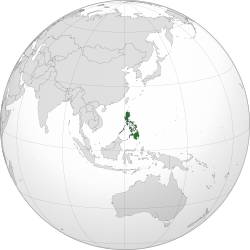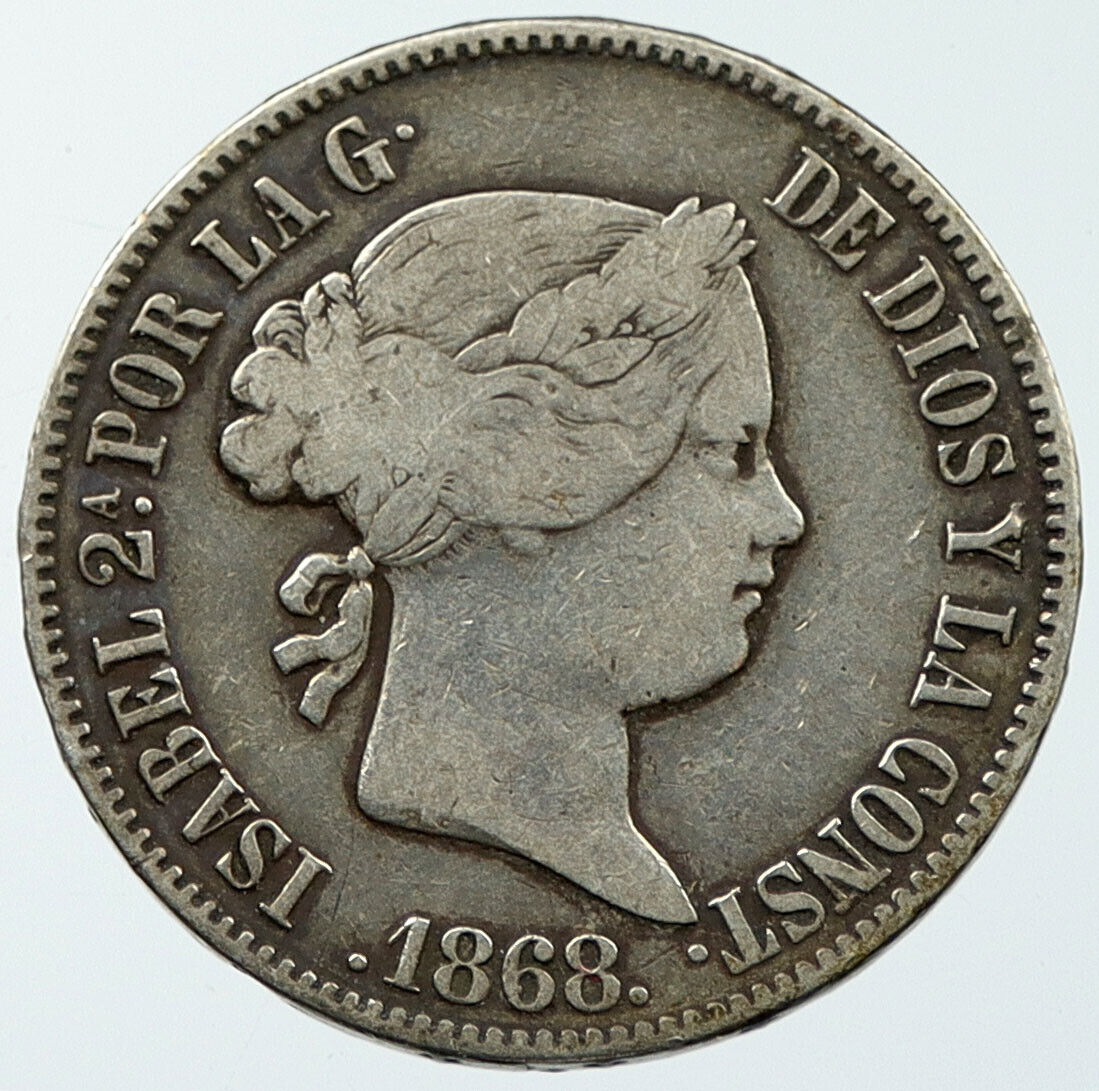|
Philippines under Spanish Rule
Alfonso XIII – King: 17 May 1886 – 14 April 1931
1897 Silver Peso 37mm (25.00 grams) 0.900 Silver (0.7234 oz. ASW)
Struck for use in the Philippines.
Reference: KM# 154 | Engraver: Bartolomé Maura Montaner
ALFONSO XIII P.L.G.D.D.REY C.DE ESPAÑA * 1897 *, Young Alfonso facing left.
ISLAS FILIPINAS PLUS ULTRA sg UN PESO v, Crowned Spanish Coat-of-Arms.
Coin Notes:
1897 Alfonso XIII is the FIRST and LAST One peso silver coin of the Philippines bearing the name Islas Filipinas. One year after its 1897 mintage, Spanish rule in the Philippine Islands officially ended with the 1898 Treaty of Paris, wherein Spain ceded the Philippines and other territories to the United States. Thus making this Un Peso circulation shortlived with full historic background. They used also in Guam and Islas Marianas
You are bidding on the exact item pictured, provided with a Certificate of Authenticity and Lifetime Guarantee of Authenticity.
 Alfonso XIII (Spanish: Alfonso León Fernando María Jaime Isidro Pascual Antonio de Borbón y Habsburgo-Lorena; English: Alphonse Leon Ferdinand Mary James Isidore Pascal Anthony of Bourbon and Habsburg-Lorraine; 17 May 1886 – 28 February 1941) was King of Spain from 1886 until 1931. Alfonso XIII (Spanish: Alfonso León Fernando María Jaime Isidro Pascual Antonio de Borbón y Habsburgo-Lorena; English: Alphonse Leon Ferdinand Mary James Isidore Pascal Anthony of Bourbon and Habsburg-Lorraine; 17 May 1886 – 28 February 1941) was King of Spain from 1886 until 1931.
Alfonso was monarch from birth, as his father Alfonso XII had died the previous year. Until his 16th birthday in 1902, his mother, Maria Christina of Austria, served as his regent, in a period which saw Spain lose its Caribbean and Pacific colonies during the Spanish-American War. Due to family ties to both sides, Alfonso kept his kingdom neutral in World War I (1914-1918).
From 1923 to 1930, Alfonso supported the dictator Miguel Primo de Rivera. In 1931, in the face of overwhelming popular rejection, Alfonso fled the country as the Second Spanish Republic was proclaimed. In exile, he retained his claim to the defunct throne until 1941, when he abdicated in favour of his third son Juan. He died six weeks later.
The Philippines, officially known as the Republic of the Philippines (Filipino: Republika ng Pilipinas), is a sovereign island country in Southeast Asia situated in the western Pacific Ocean. It consists of about 7,641 islands that are categorized broadly under three main geographical divisions from north to south: Luzon, Visayas, and Mindanao. The capital city of the Philippines is Manila and the most populous city is Quezon City, both part of Metro Manila.
 T T he Philippines’ location on the Pacific Ring of Fire and close to the equator makes the Philippines prone to earthquakes and typhoons, but also endows it with abundant natural resources and some of the world’s greatest biodiversity. The Philippines has an area of approximately 300,000 square kilometers (115,831 sq mi), and a population of more than 100 million with faster growth than any other east Asian country. It is the seventh-most populated country in Asia and the 12th most populated country in the world. An additional 12 million Filipinos live overseas, comprising one of the world’s largest diasporas. Multiple ethnicities and cultures are found throughout the islands. In prehistoric times, Negritos were some of the archipelago’s earliest inhabitants. They were followed by successive waves of Austronesian peoples. Exchanges with Chinese, Malay, Indian, and Islamic states occurred. Then, various nations were established under the rule of Datus, Rajahs, Sultans or Lakans. he Philippines’ location on the Pacific Ring of Fire and close to the equator makes the Philippines prone to earthquakes and typhoons, but also endows it with abundant natural resources and some of the world’s greatest biodiversity. The Philippines has an area of approximately 300,000 square kilometers (115,831 sq mi), and a population of more than 100 million with faster growth than any other east Asian country. It is the seventh-most populated country in Asia and the 12th most populated country in the world. An additional 12 million Filipinos live overseas, comprising one of the world’s largest diasporas. Multiple ethnicities and cultures are found throughout the islands. In prehistoric times, Negritos were some of the archipelago’s earliest inhabitants. They were followed by successive waves of Austronesian peoples. Exchanges with Chinese, Malay, Indian, and Islamic states occurred. Then, various nations were established under the rule of Datus, Rajahs, Sultans or Lakans.
 The arrival of Ferdinand Magellan in Homonhon, Eastern Samar in 1521 marked the beginning of Hispanic colonization. In 1543, Spanish explorer Ruy López de Villalobos named the archipelago Las Islas Filipinas in honor of Philip II of Spain. With the arrival of Miguel López de Legazpi from Mexico City, in 1565, the first Hispanic settlement in the archipelago was established. The Philippines became part of the Spanish Empire for more than 300 years. This resulted in Roman Catholicism becoming the dominant religion. During this time, Manila became the western hub of the trans-Pacific trade connecting Asia with Acapulco in the Americas using Manila galleons. The arrival of Ferdinand Magellan in Homonhon, Eastern Samar in 1521 marked the beginning of Hispanic colonization. In 1543, Spanish explorer Ruy López de Villalobos named the archipelago Las Islas Filipinas in honor of Philip II of Spain. With the arrival of Miguel López de Legazpi from Mexico City, in 1565, the first Hispanic settlement in the archipelago was established. The Philippines became part of the Spanish Empire for more than 300 years. This resulted in Roman Catholicism becoming the dominant religion. During this time, Manila became the western hub of the trans-Pacific trade connecting Asia with Acapulco in the Americas using Manila galleons.
As the 19th century gave way to the 20th, there followed in quick succession the Philippine Revolution, which spawned the short-lived First Philippine Republic, followed by the bloody Philippne-American War of conquest by US military force. Aside from the period of Japanese occupation, the United States retained sovereignty over the islands until after World War II, when the Philippines was recognized as an independent nation. Since then, the Philippines has often had a tumultuous experience with democracy, which included the overthrow of a dictatorship by a non-violent revolution.
The nation’s large population and economic potential have led it to be classified as a middle power. It is a founding member of the United Nations, World Trade Organization, Association of Southeast Asian Nations, the Asia-Pacific Economic Cooperation forum, and the East Asia Summit. It also hosts the headquarters of the Asian Development Bank. The Philippines is considered to be an emerging market and a newly industrialized country, which has an economy transitioning from being one based on agriculture to one based more on services and manufacturing.
|





 Alfonso XIII (Spanish: Alfonso León Fernando María Jaime Isidro Pascual Antonio de Borbón y Habsburgo-Lorena; English: Alphonse Leon Ferdinand Mary James Isidore Pascal Anthony of Bourbon and Habsburg-Lorraine; 17 May 1886 – 28 February 1941) was King of Spain from 1886 until 1931.
Alfonso XIII (Spanish: Alfonso León Fernando María Jaime Isidro Pascual Antonio de Borbón y Habsburgo-Lorena; English: Alphonse Leon Ferdinand Mary James Isidore Pascal Anthony of Bourbon and Habsburg-Lorraine; 17 May 1886 – 28 February 1941) was King of Spain from 1886 until 1931. T
T he Philippines’ location on the Pacific Ring of Fire and close to the equator makes the Philippines prone to earthquakes and typhoons, but also endows it with abundant natural resources and some of the world’s greatest biodiversity. The Philippines has an area of approximately 300,000 square kilometers (115,831 sq mi), and a population of more than 100 million with faster growth than any other east Asian country. It is the seventh-most populated country in Asia and the 12th most populated country in the world. An additional 12 million Filipinos live overseas, comprising one of the world’s largest diasporas. Multiple ethnicities and cultures are found throughout the islands. In prehistoric times, Negritos were some of the archipelago’s earliest inhabitants. They were followed by successive waves of Austronesian peoples. Exchanges with Chinese, Malay, Indian, and Islamic states occurred. Then, various nations were established under the rule of Datus, Rajahs, Sultans or Lakans.
he Philippines’ location on the Pacific Ring of Fire and close to the equator makes the Philippines prone to earthquakes and typhoons, but also endows it with abundant natural resources and some of the world’s greatest biodiversity. The Philippines has an area of approximately 300,000 square kilometers (115,831 sq mi), and a population of more than 100 million with faster growth than any other east Asian country. It is the seventh-most populated country in Asia and the 12th most populated country in the world. An additional 12 million Filipinos live overseas, comprising one of the world’s largest diasporas. Multiple ethnicities and cultures are found throughout the islands. In prehistoric times, Negritos were some of the archipelago’s earliest inhabitants. They were followed by successive waves of Austronesian peoples. Exchanges with Chinese, Malay, Indian, and Islamic states occurred. Then, various nations were established under the rule of Datus, Rajahs, Sultans or Lakans. The arrival of Ferdinand Magellan in Homonhon, Eastern Samar in 1521 marked the beginning of Hispanic colonization. In 1543, Spanish explorer Ruy López de Villalobos named the archipelago Las Islas Filipinas in honor of Philip II of Spain. With the arrival of Miguel López de Legazpi from Mexico City, in 1565, the first Hispanic settlement in the archipelago was established. The Philippines became part of the Spanish Empire for more than 300 years. This resulted in Roman Catholicism becoming the dominant religion. During this time, Manila became the western hub of the trans-Pacific trade connecting Asia with Acapulco in the Americas using Manila galleons.
The arrival of Ferdinand Magellan in Homonhon, Eastern Samar in 1521 marked the beginning of Hispanic colonization. In 1543, Spanish explorer Ruy López de Villalobos named the archipelago Las Islas Filipinas in honor of Philip II of Spain. With the arrival of Miguel López de Legazpi from Mexico City, in 1565, the first Hispanic settlement in the archipelago was established. The Philippines became part of the Spanish Empire for more than 300 years. This resulted in Roman Catholicism becoming the dominant religion. During this time, Manila became the western hub of the trans-Pacific trade connecting Asia with Acapulco in the Americas using Manila galleons.

